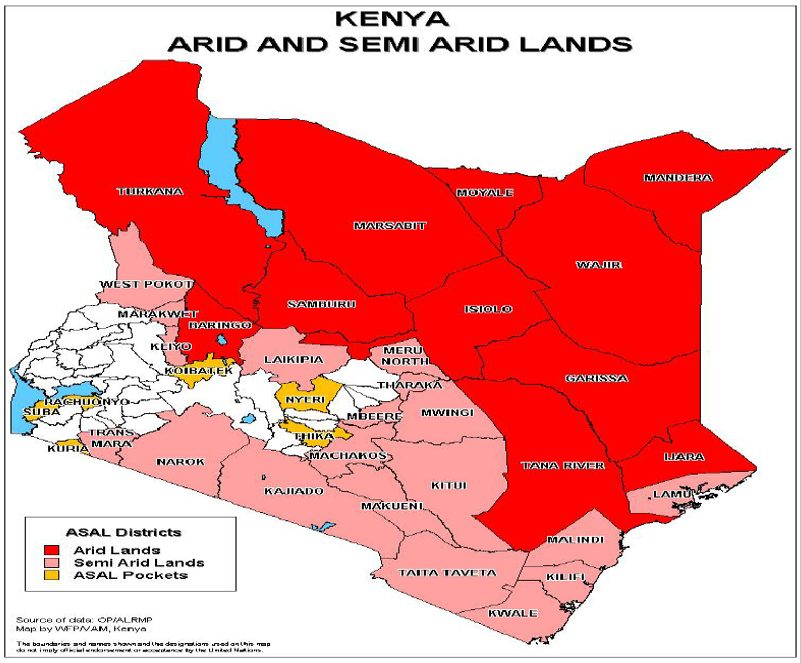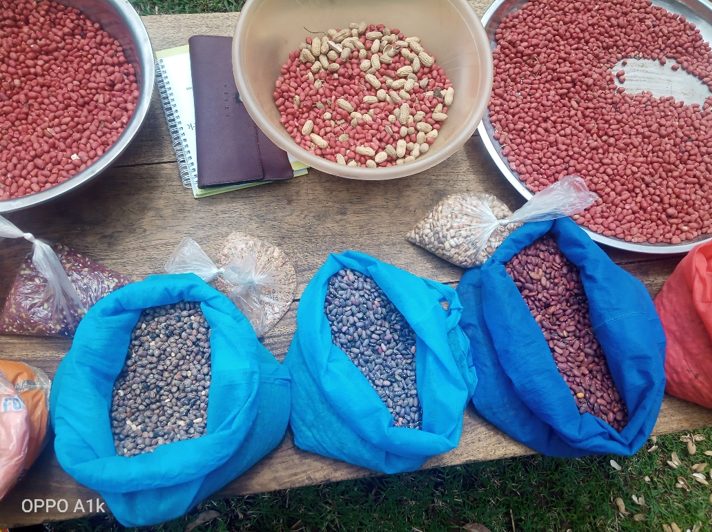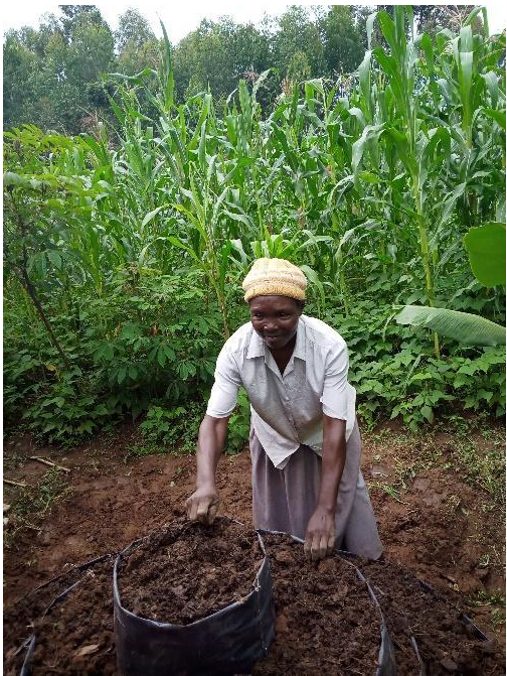Author: Mercy Ambani, Seed Savers Network Kenya
PRODUCTION OF LEGUMES IN DROUGHT STRICKEN AREAS: A CASE OF COWPEAS (Vigna unguiculata) IN BARINGO COUNTY, KENYA.
Introduction
Leguminous crops contribute effectively to food security in developing countries, yet the productivity of these crops can be restrained by adverse weather conditions such as drought. Water stress has been identified as a threat to crop yield.

Land characteristics
Many regions of Kenya can be categorized into arid and semi-arid lands that receive unsustainable rainfall of between 250mm-500mm. This amount of rainfall cannot adequately support rain fed agriculture. Crops grown in this region are sorghum and millet. Most households keep and rear livestock.
Characteristics of Arid and Semi-arid lands are Nitrogen and phosphorus-deficient soils, high temperatures, poor soil texture, structure, and erosion. Semi-arid lands receive rainfall of between 300-500mm and temperatures of range between 180C-270C. Arid land receives rainfall of less than 250mm and temperatures that go beyond 350C.
As shown in the map below some of the ASAL areas include; Baringo, Turkana, Kitui, Garissa, Kajiado, Samburu, Isiolo, Mandera, Wajir, Makueni, Marsabit, Tana River, among others.

Why legumes are preferred in ASALS
Millions of smallholder farmers in the arid and semiarid lands of Kenya prefer cultivating legumes over other cash crops – crops grown mainly for sale – due to their resistance to water scarcity their reduced water requirements. Additionally, legumes improve the soil fertility of ASALs by fixing nitrogen in the soil.
Most leguminous crops are used as food, fodder for animal supplements, green manure, and cover crops. They also attract more cash when sold. This is because they can be sold as leafy vegetables, fresh seeds, pods, and dry beans and their forages converted to animal feeds.
Uses of legumes
Leguminous crops like a common bean (Phaseolus vulgaris), green grams (Vigna radiata), pigeon pea (Cajanus cajan), cowpea (Vigna unguiculata), and soybean are tolerant to high temperatures.
Indeed, most farmers grow Phaseolus vulgaris because of their contribution to dietary proteins, and their boosting of soil fertility. It is usually intercropped with other crops such as maize, sorghum, and millet.

Chickpea (Cicer arietinum) is also largely grown in dry areas. The farmers prefer indigenous varieties because of higher resistance to water stress than the common bean. Farmers in these areas have also realized this crop is more tolerant to pests and diseases than other legumes and highly in-demand both locally and internationally. Chickpea when intercropped with other crops it increases crop yield.
Soybean is a leguminous crop with high protein and oil content. The crop takes between 3-6 months to mature. Soybean adapts to wider climatic conditions, through a high resistance to water stress for example. Soybean is one of the industrial legumes that is processed into various products such as flour, milk, and protein products.
The Pigeon pea is a perennial legume from the family of Fabaceae that adapts well in areas with less rainfall. Pigeon pea is consumed either as dry or green pulses and served as a stew. Most farmers in ASALs have large herds of cattle – Each household has an average of 10 cattle and 30goats – and therefore, pigeon pea forage is given to the livestock.
Lastly, Green Grams need 60-90 days to get to a mature stage, and are grown in arid and semi-arid areas for subsistence and as a cash crop. Its advantages include a notable ability to escape drought periods because of its early maturing nature, which makes it grow in drought-prone areas.
Cowpea Cultivation in Baringo County
Baringo county is approximately 8653KM2, at an an altitude of 1067 meters above sea level. Baringo county is largely an arid area with just a small area experiencing semi-arid conditions. It has its dry months between October to March and receives rainfall between April and July. Baringo is a county that experiences drought in most of the months
Additionally, most of the farmers in the county are subsistence farmers who largely depend on field crops for food and nutritional security.

The smallholder farmers produce a wide range of legumes but the most common is cowpeas.
Green pods are handpicked while still tender, about 12-16 days after flowering. Matured, dried pods are harvested on time to prevent them from dehiscing while still in the fields.
Delayed harvesting encourages infestation with weevils, and seed shattering and in humid weather, the grains may deteriorate. The leaves and grains are widely consumed across the Kenyan population at large. Its leaves are combined with other dishes for consumption. The leaves are dried and preserved in order to lengthen their shelf-life which is mostly 24 hours. However, its leaves are mostly consumed in their fresh form. The leaves are utilized as boiled or fermented vegetables. The entire plant can also be pulled especially if most of the pods are mature to feed animals as fodder.
Cowpeas are drought tolerant when exposed to field conditions, this is because their leaves do not usually wilt but tend to orient more vertically, tracking the sun in a manner that minimizes the interception of solar energy. Additionally, the cowpeas have an extensive deep root system that makes them survive under drought conditions. These mechanisms contribute to the unique ability of cowpeas to survive extreme vegetative-stage droughts that kill most of the other crop plants.
Adapt seeds and cultivation practices to conditions of drought
Local varieties are passed down from generation to generation. The varieties are able to adjust and adapt to the changing climate. However, most farmers in ASALs are affected by poor soil fertility, inadequate farm inputs, pests and diseases and poor timing of the planting season because of a lack of adequate information.
Comparison of data for Kitui Central
| Legume crop | Untapped potential 1994(Kg/acre) | Better farming methods 2020(Kg/acre) |
| Cowpeas | 78.5 | 222.4 |
| Pigeon peas | 32.5 | 105.6 |
| Green grams | 33.6 | 115.7 |
Generally, Drought stress is considered a limiting factor to legume yield productivity. The impact of drought on legume productivity varies depending on the stage at which the crop faces water stress. Legumes that are affected by drought during the reproductive stage give very little yields as compared to when affected during the vegetative stage. The traditional types of legume seeds adapt to the environment more than the certified seeds produced by agricultural firms.
Legumes such as chickpeas, cowpea, pigeon pea, and green gram were found by farmers to survive the harsh effects of drought than dry beans, and soybeans. legumes are found by farmers to survive the harsh effects of drought than dry beans, and soybeans. They are; moderately resistant to fungal diseases, tolerant to high temperatures of more than 330C, have the ability to fix atmospheric nitrogen thus able to replenish low fertility soils, have high nutrition value, fetch high income when sold, and are resistant to parasitic weeds.
Impact created on farmer fields after trainings
Seed Savers Network Kenya has trained Farmers in these areas (Baringo, Kitui, Makueni and Turkana) practice the following measures to help reduce the impact of drought on their crops:
- Use of organic manure to improve the soil structure and water holding capacity. Most soils in the arid and semi-arid areas are sandy soils that have poor water retention capacity.
- Use of indigenous legume seed types that easily adapts to climate variability. Most traditional seed types grow well in this environment under improved and better farming methods.
- Practicing farming using improved methods of farming such as conservation farming, and agro-ecology techniques.
- Training farmers on water and soil conservation measure so as to have farm produce in the most of the months.
- Sustainable land management practices that prevent soil erosion, which leads to declining soil fertility.
- Crop diversification
Seed Savers Network is working together with the smallholder farmers to improve food security, and diet diversification of many households in the ASALs.
Sustainable agricultural production and food security are achieved with respect to employing strategies that aim at adapting to changing climatic conditions. Seed fairs help to ensure availability of local varieties.
Annex – Cowpea maturation
Cowpeas take 60-120 days to mature, and can be intercropped with other crops such as Maize. Leaves meant for consumption as vegetables are harvested while young and tender, and therefore leaf picking can start 2-3weeks after planting. Pods are harvested green or dry depending on the preference of the farmer.

